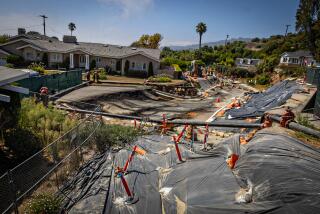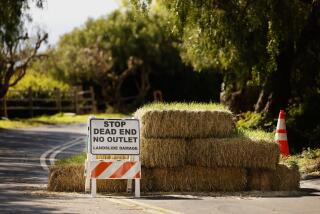Big Island homes appear doomed by lava from Kilauea
- Share via
Reporting from PAHOA, Hawaii — Encroaching lava from Kilauea volcano slowed Monday, giving residents of this Big Island village a reprieve as they braced for what seemed inevitable: an inundation that is likely to destroy homes and threaten the town’s very existence.
Hawaii County Civil Defense Director Darryl Oliveira had predicted Saturday that the lava, which has already crossed the road on the outskirts of town, was likely to reach the first houses by Tuesday.
The lava had been flowing at a rate of 10 yards per hour, but the speed doubled Sunday. As of Sunday afternoon, the closest occupied home was 300 yards from the front of the flow. And by Sunday evening, Civil Defense workers were knocking on the doors of 40 to 50 houses to inform residents that the evacuation advisory would probably become an evacuation order.
At one point Monday, officials said the lava had come within 100 yards of the nearest home and could reach it by evening. But then topography intervened.
Hawaiian Volcano Observatory geologist Frank Trusdell said the lava had picked up speed as it flowed downhill, but once the land flattened out in a pasture, the lava slowed — at least for the moment.
“Lava moves in fits and starts,” Trusdell said.
By Monday evening, geologists from the Hawaiian Volcano Observatory said the lava had advanced to within 70 yards of the nearest home.
Kilauea has been erupting for 31 years, but a new vent opened in June. That vent is threatening Pahoa, which is about 20 miles southwest of Hilo.
During Kilauea’s eruption, Trusdell said, the volcano has emitted about 350,000 square meters of lava a day. The new vent is emitting far less — about 100,000 square meters a day.
But the lava is moving through well-defined topography that is keeping it on a more concentrated path.
Oliveira said authorities were prepared to issue an evacuation order when necessary, but were sensitive to the emotional trauma victims faced.
“As with past flows, our policy is to let people remain in their property until the last possible moment,” he said. “Many of these residents have lived in their homes for generations. We want to give people every opportunity for closure, to document the event for insurance purposes, as well as family history, and to respect the grieving process in this difficult time.”
More to Read
Sign up for Essential California
The most important California stories and recommendations in your inbox every morning.
You may occasionally receive promotional content from the Los Angeles Times.










